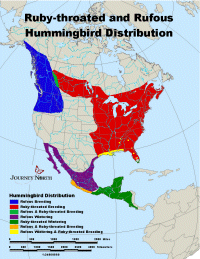Questions for Banders Scott Weidensaul and Fred Bassett

Fred Bassett

Hummingbird Distribution
How long have Rufous wintered in the Eastern and Southeastern US?
Both Weidensaul and Bassett believe that hummingbirds have always wintered the E and SE regions of the US, although the winter population found in the US is small.The first recorded Rufous found east of the Mississippi was collected in 1909. Nancy Newfield, a Louisiana bird bander, documented Rufous and other hummingbirds in the 1970’s. Her early work helped the scientific community understand that these migrants were not just lost and doomed birds, which was popular thinking up till then.
Why are some Rufous migrating into the Eastern states?
Although this is a small portion of the population those that migrate east are genetically programmed. "These hummingbirds are doing exactly what they know. Their behavior is stamped into their genes. They fly east instead of south to Mexico and Central America in the winter," believes Weidensaul.
What route do they take on fall migration?
Rufous migrate south from their breeding grounds in late summer. Instead of continuing to fly south along the Rockies like most do, these birds turn east. Eventually they turn south toward regions along the Gulf Coast and SE states, say Weidensaul and Bassett. Bassett gave an example of a bird that was banded in the fall in Oklahoma and arrived in Alabama one week later where it then stayed all winter. Weidensaul has observed fall/winter Rufous sightings in Pennsylvania as well as Allen's, Caliope, Anna's, Black-chinned and a Bahama Woodstar.
What is the spring migration route?
Weidensaul and Bassett both think the Rufous migrate west in the spring across the Gulf States and then north via California to the breeding grounds. Fred Dietrich, a bird-bander, caught an immature Rufous in Florida in January that was recaptured along the Mexico-California border in the spring. This information, along with banding data from Louisiana, seem to confirm Weidensaul and Bassett's assumptions.
How have citizen scientists contributed to what we know?
Since it has become better known that some hummingbirds stay through the fall and winter, people are keeping their feeders up. The sighting data these citizen scientists provide help to answer some of the questions.
Are winter populations stable from year to year?
Bassett has observed cyclical population patterns occurring for several species. For example, in the past 2 years, his Rufous banding numbers are down from 110 to 80, and numbers continue to decrease this winter. He has observed that while the numbers of adults returning each year to the same territories has stayed steady, during low cycles he sees fewer juvenile birds.
How do the hummingbirds stay alive in cold winter temperatures?
It is common in winter for cold temperatures to send hummingbirds into torpor. Hummingbirds that breed in the far north, like Rufous, or at high altitudes commonly use torpor to reserve their energy, explained Bassett. In addition to the cold, torpor can be triggered when a bird has too few reserves/food sources to sustain their body's high metabolism. Torpor lowers a bird's metabolic rate and conserves energy until food or warmer temperatures arrive. This behavior allows hummingbirds to survive winter in the U.S.
Do wintering hummingbirds return to the same territories?
Many wintering Rufous are faithful in returning to the same territories. Bassett's record for recapturing the same bird in the same yard in Alabama is 9 years in a row. DNA research has shown that offspring of these faithful birds also return to the same location where their parents were banded.
What questions do you still have about these birds?
Within a few years there may be a tracking device small enough to be strapped onto a hummingbird. When this happens I’d like to know how many stops and what directions they travel in their migration. I’d particularly like to know about the habits of the Rufous that are recaptured year after year in the same yards. -Fred Bassett
It would be great to know the origin point on their breeding grounds for these SE birds. Are they coming randomly, or as I suspect, are they coming from a fairly restricted breeding area. Research is underway to use feather samples from young birds that were grown at point of origin. Scientists could use feather isotope analysis to determine point of origin and see if they’re similar within the population of the SE overwintering birds. This work has been started. -Scott Weidensaul
Journey North is grateful to Scott and Fred for providing information that helps us further understand the interesting complexities of hummingbird migration.



